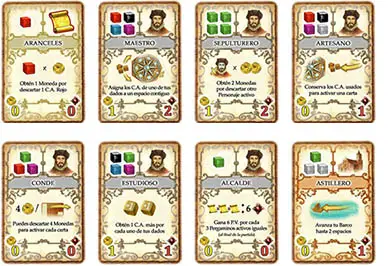
All 120 cards are structured as follows:
-
At the top left, the card displays the exact number and colors of AC a player must pay to activate the card. The activation costs vary between 1 and 4 AC in all possible color combinations.
-
At the top right is a graphic which indicates the kind of card this is: office, building, or person.
-
Under these is the name of the card (with a background noting the kind of card: office (yellow), building (red-brown), and person (gray). Below this is text which describes what the card does.
-
At the bottom of the card are two numbers, left and right, which show the exchange rate values for the tribute table. The numbers vary among 0-0, 1-1 and 2-2 (20 each) and 0-1 and 1-2 (30 each).
-
Between these two numbers is an indication when the card can be used. If nothing is written, it is used in the 3rd phase. Otherwise, it will indicate when it can be used (1st or 2nd phase, or at game end).

The 24 office cards are designed such that the activation cost is evenly: distributed among the colors red, blue, green, gray, violet, and black with four of each color showing 1 to 4 like-colored AC each.
The 44 building and 52 person cards also have activation costs of 1 to 4 AC each, but with a variety of like and different colored AC.

The basic rules for the use of all 120 cards:
-
A player may only use activated cards; the cards on a players tableau have not been activated and cannot be used.
-
Each card may be used at most once per round to do what is described on the card, unless the card specifically says otherwise (like, for example, "in each case", "everyone", or "every time").
-
With few exceptions, all cards are used in the 3rd phase ("actions"), when the owner of the card is taking his turn.
For cards that are not used in the 3rd phase, there is text along the bottom of the card describing when it can be used.
-
Once activated, cards may be used immediately, even in the same round as the activation!
-
Remember: cards will use the following abbreviations: action cube(s) -AC, gold coin(s) - GC, and prestige point(s) - PP.
-
When a card directs a player to take AC, the player always takes them from the general supply and places them in his action cube supply; when a player pays AC, he always takes them from his action cube supply and places them in the general supply.
-
It is important to remember that the rules are intended to be read and followed with reason and normalcy. Players should not look for ways to to read the rules so as to make unreasonable actions legal or reasonable actions illegal.
Continue Reading
